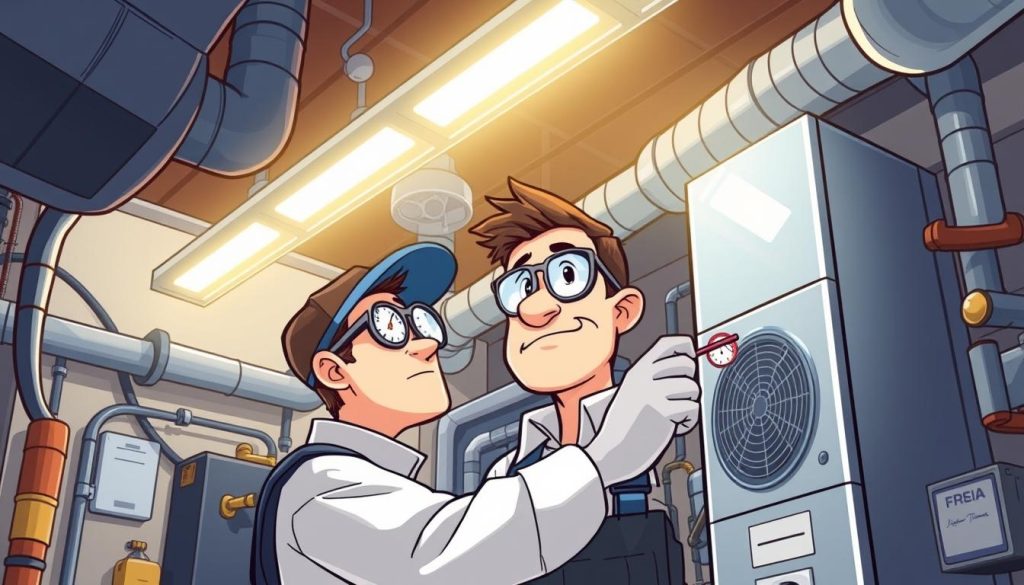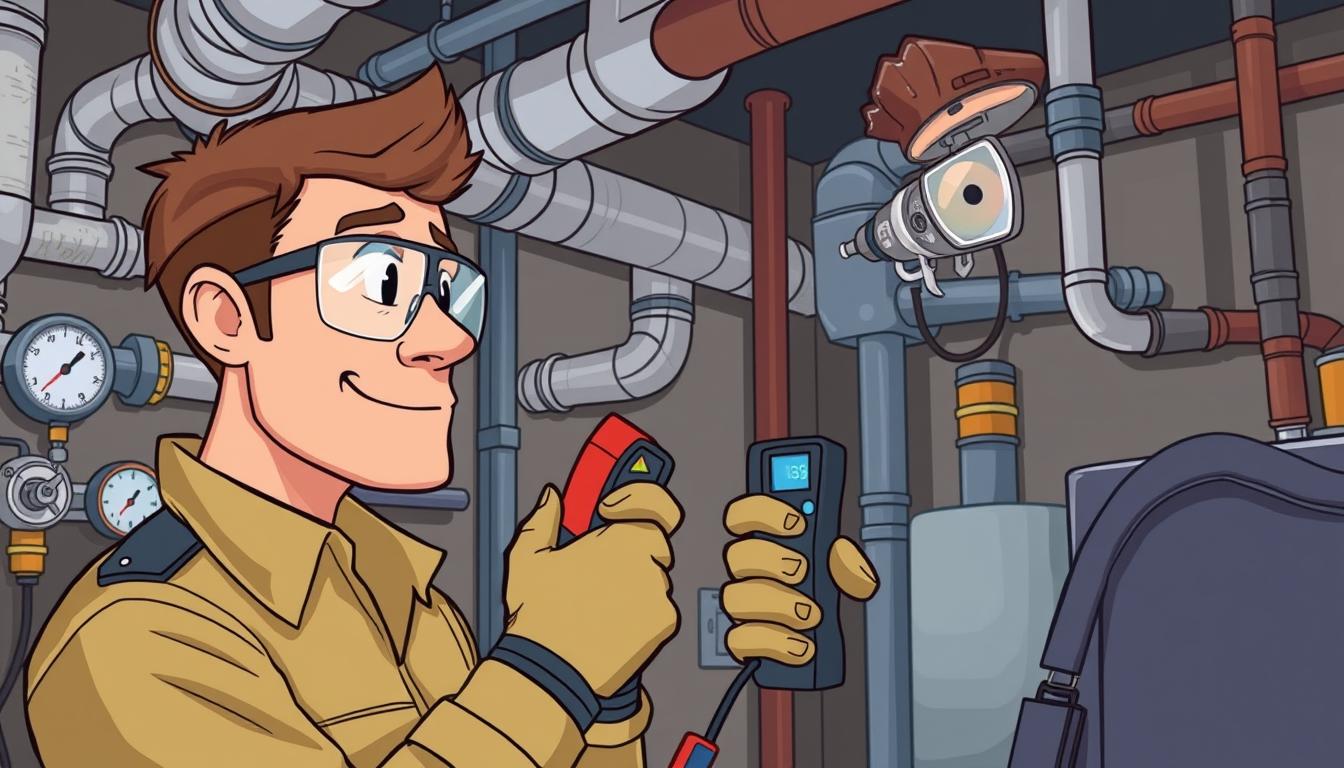As an HVAC technician, finding and fixing refrigerant leaks is key. Refrigerants keep HVAC systems running well. Without them, systems don’t work right. Luckily, HVAC techs have many ways to find and fix leaks.
Key Takeaways
- HVAC techs use a combination of audible, visual, and electronic methods to detect refrigerant leaks
- Soap bubble tests, nitrogen sensors, and specialized leak detectors are common tools for the job
- Proper leak detection is crucial to maintaining system efficiency and preventing environmental harm
- Techs must follow safety protocols when handling refrigerants and performing leak tests
- Regular preventive maintenance helps minimize the risk of future refrigerant leaks
The Importance of Refrigerant Leak Detection
When your air conditioning or commercial refrigeration system isn’t working right, a refrigerant leak might be the problem. Finding and fixing these leaks early can save you and your customers a lot of money. It also helps avoid expensive breakdowns and high energy bills.
Impact on Equipment Performance
A slow refrigerant leak can make your HVAC system work too hard. It tries to cool down but ends up wasting energy. This also makes the parts wear out faster, leading to more costly repairs later.
Fixing the leak helps your system work better and last longer.
Environmental and Cost Considerations
Many refrigerants used in cooling systems harm the environment. They can damage the ozone layer and contribute to global warming. As an HVAC technician, you’re key in keeping these harmful substances from leaking into the air.
Leaks also make your customers’ systems use more electricity. This increases their energy bills.
| Refrigerant Leak Impact | Potential Consequences |
|---|---|
| Equipment Performance | – Reduced efficiency and cooling capacity – Increased energy consumption – Accelerated component wear and tear |
| Environmental Impact | – Ozone depletion – Greenhouse gas emissions – Increased carbon footprint |
| Cost Considerations | – Higher utility bills for customers – Potential for equipment breakdown and costly repairs – Lost revenue for businesses dependent on functioning HVAC or refrigeration |
By finding and fixing refrigerant leaks early, you help your customers. You keep their cooling systems running well. You also protect the environment and save them money in the long run.
Traditional Refrigerant Leak Detection Methods
In the past, HVAC techs used old ways to find refrigerant leaks. They listened for sounds or looked for oil stains. But these methods were not always right, especially for small leaks.
Audible and Visual Leak Indicators
Small refrigerant leaks often make no sound and leave no marks. Using audible and visual leak indicators was not the best way. Techs had to search a lot to find the leak.
Soap Bubble Test
The soap bubble testing was a common method for years. It used soapy water on lines and coils to find leaks. But it wasn’t always right, especially for small leaks. It also left a big mess.
Nitrogen Sensors
The nitrogen sensor leak detection tool used a metal rod with liquid nitrogen. When passed over lines, leaks made the nitrogen solidify. This method helped find leaks but wasn’t perfect.
These old methods had big problems. They missed small leaks and were messy and slow. There was a clear need for better, more accurate tools.
Electronic Refrigerant Leak Detection Tools
Electronic tools have changed how we find refrigerant leaks in HVAC systems. They use advanced sensors to spot even tiny leaks. This makes the job easier and faster for HVAC techs.
Heated Diode Detectors
Heated diode detectors are a top choice for finding refrigerant leaks. They work by breaking down refrigerant molecules into ions. When a leak is found, the tool alerts you. They’re great at finding small leaks but need more cleaning and upkeep.
Ultrasonic Detectors
Ultrasonic leak detectors catch the faint sounds of refrigerant gas escaping. They’re super sensitive to pressure changes, helping find leaks accurately. These detectors can hear sounds we can’t, making them very useful.
Infrared Detectors
Infrared leak detectors use infrared light to find leaks. They’re very accurate and rarely give false alarms. The only catch is you need to move the probe to detect leaks. Despite this, their reliability makes them a favorite among HVAC pros.
Using these electronic tools, HVAC techs can find and fix leaks better. This improves system performance, cuts down on environmental harm, and saves money on repairs.
Factors to Consider When Choosing a Leak Detector
When picking an electronic refrigerant leak detector for HVAC work, think about a few key things. Choosing the right features ensures you get a tool that fits your needs. It should also last a long time and work well.
Wide Range of Detectable Gases
Find a leak detector that can find many refrigerant gases. This includes R-22, R-410A, and R-134a. Being able to use one device for different HVAC systems saves time and money.
Ease of Use
If you’re new to HVAC, an easy-to-use leak detector is a big help. Look for one with a clear display, simple controls, and an easy setup. This makes your job easier and faster.
Durable Construction
HVAC work is hard on tools, so a tough leak detector is important. Choose one with a strong body, durable parts, and other features that can handle the job site.
Warranty and Maintenance
A good warranty, usually 1 year or more, gives you peace of mind. Also, know what maintenance your leak detector needs. This could be replacing sensors to keep it working well.
Power Options
Think about whether you need a leak detector that runs on a rechargeable battery or one that plugs into AC power. Battery-powered ones are great for moving around, while AC-powered ones are better for staying in one place.
By looking at these factors, you can find a refrigerant leak detector that meets your HVAC needs. It should be reliable and last a long time.
Tracer Gas Testing for HVAC Leak Detection
Tracer gas testing is a top-notch way to find leaks in HVAC systems. It can spot tiny leaks that other methods miss. This method is often paired with pressure decay testing for a complete check.
Pressure Decay Testing
Pressure decay testing is a first step in finding leaks. It fills the HVAC system with air and watches the pressure. If the pressure drops, it means there’s a leak. This method finds big leaks, and then tracer gas testing finds the small ones.
Helium Tracer Gas Testing
Helium tracer gas testing is great for finding tiny leaks. First, the system is emptied and filled with helium. A special analyzer finds any helium that escapes, showing where the leak is. This method also tells how fast the leak is leaking, helping with repairs.
Tracer gas testing is key for HVAC techs. It keeps systems running well and efficiently. Finding small leaks early saves time and money, making HVAC systems more reliable.
How do HVAC techs check for leaks?
Ensuring your HVAC system is leak-free is key for its efficiency and safety. Refrigerant leaks can harm your system’s performance, the environment, and your energy bills. HVAC techs use several methods to find and fix leaks in HVAC systems.
Step-by-Step HVAC Technician Leak Detection Process
HVAC technicians follow a detailed process to check for leaks:
- Visual inspection: They look closely at the HVAC system for damage, cracks, or corrosion that might cause a leak.
- Auditory cues: Techs listen for hissing or bubbling sounds that could mean a refrigerant leak.
- Soap bubble test: They use a soap and water mix on possible leak spots to see if bubbles form, showing a leak.
- Nitrogen sensor: HVAC techs might use a nitrogen sensor to find refrigerant in the air, helping locate a leak.
- Electronic leak detectors: Advanced tools like heated diode, ultrasonic, or infrared detectors can find even small refrigerant leaks.
HVAC Leak Detection Best Practices
To detect leaks well, technicians follow these best practices:
- Comprehensive system inspection: They check the whole HVAC system, including coils, compressors, and fittings, for leaks.
- Proper equipment calibration: They make sure their leak detection tools are set right and work well.
- Systematic testing procedures: They test each part and joint of the HVAC system to find leaks.
- Careful documentation: They write down their findings and the steps they took during the leak inspection.
By sticking to these best practices, HVAC pros can find and fix refrigerant leaks in your system. This ensures your system works well and uses energy efficiently.

Nitrogen Purge Testing for HVAC Fittings and Joints
Keeping HVAC system parts in good shape is key for top performance and energy use. Nitrogen purge testing is a great way to find leaks in HVAC fittings and joints. This method, using the TracerMate II system, is very accurate and reliable for spotting small leaks in HVAC gear.
The nitrogen purge test fills the area being checked with nitrogen to push out air. Then, the part is vacuumed and filled with a gas like helium. If helium leaks out and mixes with the nitrogen, a mass spectrometer can find it. This helps technicians find even the tiniest nitrogen purge leak testing or HVAC component leak testing.
The nitrogen purge test setup comes in both fixed and portable versions. This makes it easy to check HVAC fittings and joints leak detection on many system parts. It’s great for getting into tight spots in HVAC units, making sure no leaks are missed.
| Key Benefits of Nitrogen Purge Testing | Comparison to Traditional Methods |
|---|---|
|
|
Adding nitrogen purge testing to your HVAC upkeep can make your system last longer and work better. It also cuts down on the cost and harm of refrigerant leaks. This cutting-edge tech is a full solution for finding leaks in HVAC fittings and joints.
Ultraviolet (UV) Dye Method for Detecting Leaks
Dealing with a refrigerant leak in your HVAC system? The ultraviolet (UV) dye method is a great way to find the leak’s exact spot. It works by adding a fluorescent dye to your system. This dye sticks to leaks and glows under a UV lamp, making repairs easier.
The UV dye leak detection is simple. First, a technician adds UV-reactive dye to your HVAC system. The dye goes to any leaks, making them glow under UV light. Then, the technician uses a UV lamp to find the leak’s exact spot.
- UV dye leak detection works on many HVAC systems, from homes to big buildings.
- The fluorescent dye leak testing is quick, taking just a few minutes.
- This method helps HVAC techs find leaks accurately, leading to better repairs.
The UV dye method is great at finding small leaks. It’s very sensitive and can spot tiny cracks or openings. Plus, the dye is safe and works with most refrigerants, making it good for the environment.
Think you have a refrigerant leak? Get a pro to check it out with UV dye. This method saves time, money, and stress by quickly finding and fixing the problem.
Preventive Maintenance to Minimize Refrigerant Leaks
Keeping your HVAC system in top shape is key to avoiding refrigerant leaks. Regular maintenance by HVAC experts can help prevent costly repairs. It also boosts your system’s efficiency.
Routine Inspections and Checkups
Experts suggest getting your HVAC system checked every six months or a year. During these visits, technicians look for leaks and worn parts. This early action can save your system from major damage and extend its life.
Component Replacements
Technicians also suggest replacing parts like gaskets and seals. These parts often leak refrigerant. Replacing them early can keep your system running smoothly and prevent leaks.
System Cleaning and Tuning
Cleaning and tuning your HVAC system helps too. Technicians clean coils and filters for better airflow. They might also adjust the refrigerant to keep it at the right level.
| Preventive Maintenance Task | Frequency |
|---|---|
| Comprehensive System Inspection | Bi-annual or Annual |
| Component Replacements | As Needed |
| System Cleaning and Tuning | Bi-annual or Annual |
Being proactive with HVAC maintenance can greatly reduce refrigerant leaks. It also makes your system last longer. This effort saves you money and keeps your space comfortable.

Safety Considerations in Refrigerant Leak Detection
As an HVAC technician, it’s key to handle refrigerants safely. This is for your safety and the environment’s. Older refrigerants like R-22 are being phased out because of their harm to the environment. Yet, they’re still in many HVAC systems, so it’s vital to be careful when checking for leaks and fixing them.
Handling Refrigerants
Always wear the right personal protective equipment (PPE) when working with refrigerants. This includes goggles, gloves, and a respirator. Refrigerants can be dangerous if breathed in or touched, so it’s crucial to avoid direct contact. Also, remember that some refrigerants can catch fire or explode, so follow all safety rules closely.
Refrigerant Leak Detection Safety Precautions
- Make sure the work area has good ventilation to prevent refrigerant vapors from building up.
- Stay away from open flames or sparks near the HVAC system, as some refrigerants can catch fire.
- Always follow the manufacturer’s guidelines for the refrigerant you’re working with. Different types need different handling.
- Dispose of any refrigerant you recover correctly, following local and federal laws.
By taking the right refrigerant handling safety steps and using the right HVAC technician personal protective equipment, you can lower the risks of refrigerant leak detection. This ensures a safe work environment for you and your team.
Certification and Training for HVAC Technicians
Being an HVAC technician means you need the right training and certification. This is crucial for safely finding and fixing refrigerant leaks. The EPA 608 certification is key, as it teaches how to handle and dispose of refrigerants correctly.
The EPA 608 certification is a must for anyone working with refrigerants. It shows that technicians know the environmental and safety risks. Besides the EPA 608, HVAC techs might also need other certifications. These could be from training programs or HVAC technician certification.
The Importance of Proper Training and Certification
Why is proper training and certification so important for HVAC techs?
- It ensures they follow federal, state, and local laws about refrigerants.
- It helps them learn how to find and fix refrigerant leaks well.
- It keeps HVAC systems running right, which is important for their performance and efficiency.
- It helps protect the environment by reducing harmful refrigerant releases.
Obtaining the EPA 608 Certification
To get the EPA 608 certification, you must pass a test. The test covers:
- What refrigerants are and their properties.
- How to handle and store refrigerants safely.
- Methods for finding and fixing leaks.
- How to recover and recycle refrigerants.
- Important environmental and safety laws.
To get ready for the EPA 608 test, HVAC techs can take a training program. Or, they can study on their own. Many schools and colleges offer HVAC training programs that help prepare for this certification.
| Certification | Description | Importance |
|---|---|---|
| EPA 608 certification | Covers the proper handling and disposal of refrigerants | Mandatory for anyone working with refrigerants |
| HVAC technician certification | Demonstrates expertise in HVAC system installation, maintenance, and repair | Enhances job prospects and professional credibility |
| HVAC training programs | Provide comprehensive education and hands-on experience in HVAC system technology | Prepares technicians for certification exams and real-world HVAC work |
Conclusion
Keeping your HVAC system in top shape is key, and it begins with finding refrigerant leaks. HVAC techs use many methods, from the soap bubble test to high-tech tools, to spot leaks. This helps avoid damage, cuts energy costs, and protects the environment.
It’s vital to have HVAC techs who are well-trained and certified. They know the latest ways to find and fix leaks. With tools like heated diode detectors and infrared tech, finding leaks is easier than ever.
Regular HVAC maintenance and the help of skilled techs keep your space comfy and energy-smart. Focus on finding and fixing leaks to enjoy a reliable HVAC system for years to come.





0 Comments